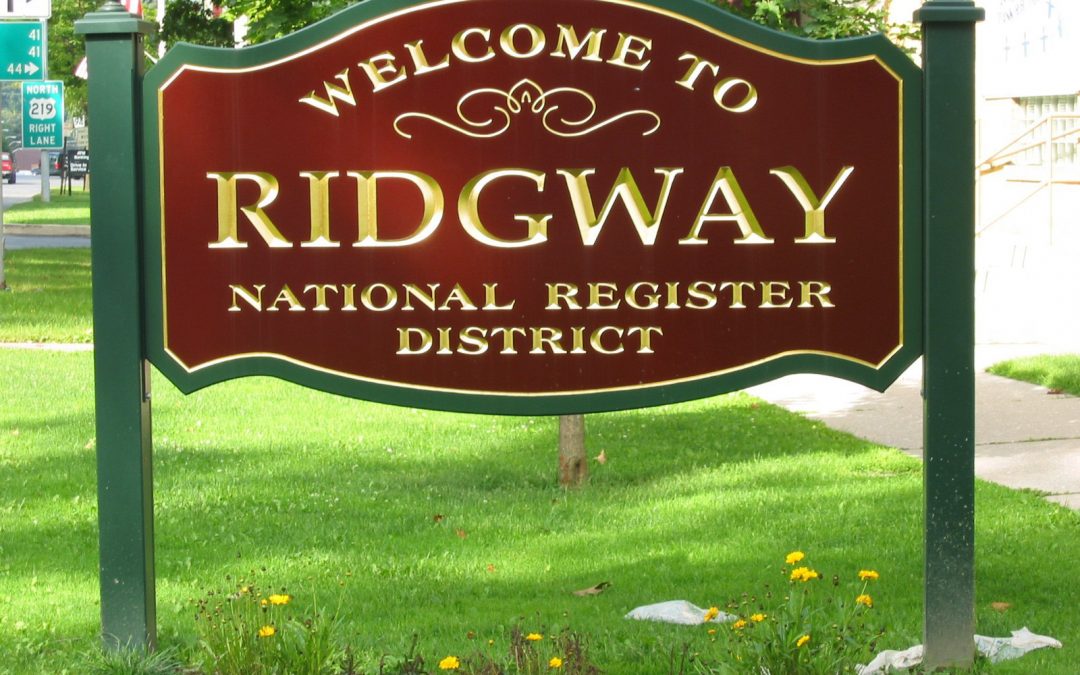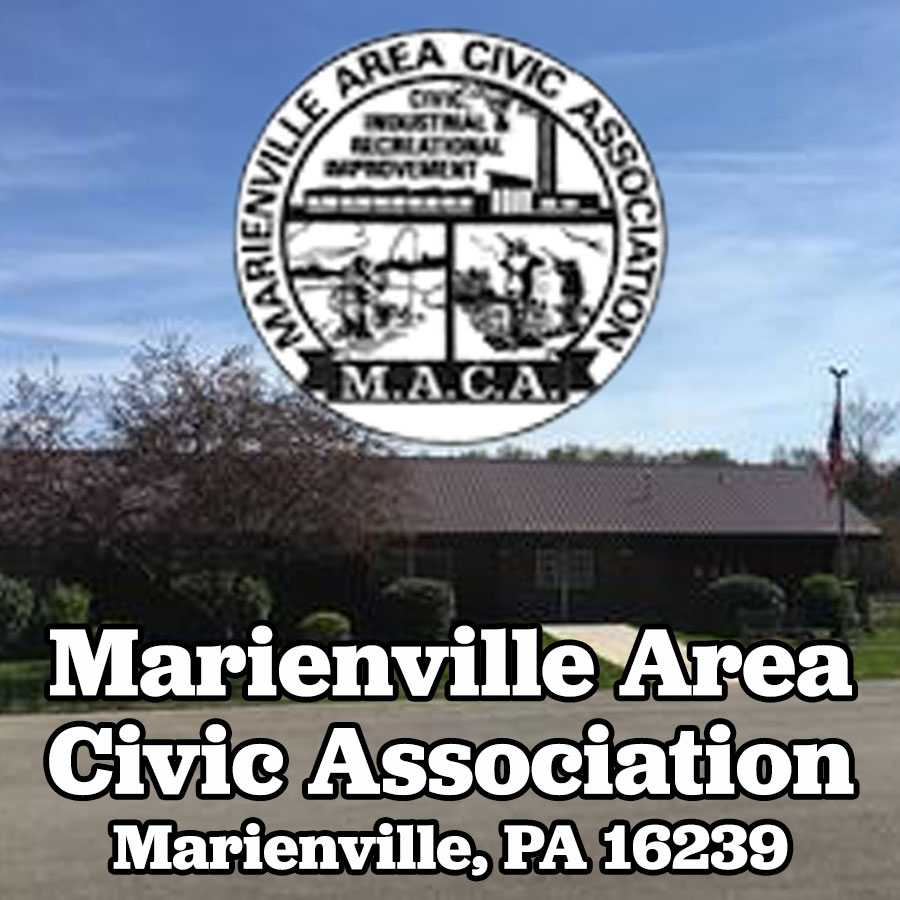This year is Ridgway’s Bicentennial, and many events are planned throughout the year to celebrate. Here is a look the last 200 years in Ridgway by Bob Imhof.
1817 Jacob Ridgway, a wealthy Philadelphia businessman, purchased 120,000 acres of land in the counties of McKean and Jefferson in 1817. This land became available following the Treaty of Fort Stanwix (now Rome, New York) on October 23, 1784, when the Six Nations Indians signed away their last remaining land in Pennsylvania. 40,000 acres of this purchase would become Elk County in 1843. Mr. Ridgway was reputed to have been worth over $6,000,000 when he purchased the lands that would eventually become Elk County in 1843, making him the wealthiest man in Pennsylvania since Steven Girard. Using three methods of calculation, the Consumer Price Index, the Purchasing Power Calculator, and the Gross Domestic Product Calculator Mr. Ridgway’s $6,000,000 in 1817 would be worth $113,207,547.17 and $131,000,000 for the Purchasing Power Calculator and a staggering $135,000,000,000 using the Gross Domestic Product Calculator in 2023.
Stephen Girard (May 20, 1750 – December 26, 1831; born Étienne Girard) was a French-born, naturalized American, philanthropist and banker. He personally saved the U.S. government from financial collapse during the War of 1812, and became one of the wealthiest people in America, estimated to have been the fourth richest American of all time, based on the ratio of his fortune to contemporary GDP.[2] Childless, he devoted much of his fortune to philanthropy, particularly the education and welfare of orphans. His legacy is still felt in his adopted home of Philadelphia.
1821 James Lyle Gillis, nephew of Jacob Ridgway by marriage, was appointed the land agent for Mr. Ridgway’s holdings. Mr. And Mrs. Gillis and their three children arrived by packhorse and ox-team at the Montmorency site along present day PA Route 948, 6 miles north of present-day Ridgway on December 21, 1821.
A. Two versions are given as to how the name “Montmoreci(y)” originated:
- Paul Busti, of the Holland Land Company in Philadelphia and the person most instrumental in selling the lands that would eventually become Elk County to Jacob Ridgway was born in Montmorenci, Italy near Florence.
- James Lyle Gillis named the area Montmorency after Lord Montmorency of England.
- 3. A third option recently discovered is based on the amount of time Mr. Ridgway spent in Europe especially France, Belgium and England developing his trading partners in the shipping business. Montmorency, located in the northern suburbs of Paris was the fief of the Montmorency family, one of the oldest and most distinguished families of the French nobility, who owed their name to the location of their ancestral castle on the promontory of Montmorency. The castle of Montmorency was destroyed by the English during the Hundred Years’ War and was not rebuilt. After the Hundred Years’ War, the Montmorency moved their residence to the Château d’Écouen in Écouen, 5.6 km (3.5 mi) to the northeast of Montmorency
1820’s Joseph Willis Taylor, who, in 1820, came to the area that would become Elk County with his father, Libni Taylor, died May 1, 1885. He aided in clearing the four hundred acres of the Montmorency farm, and it is said cut the first tree on the site of Ridgway where the present courthouse stands, before James Gallagher’s arrival in 1825. Mr. Taylor later worked for James Gallagher in his tannery.
1821 – 1823 James Lyle Gillis and several men cleared four hundred acres at the Montmorency site. The maple trees that remain along both sides of PA Route 948 bordered the main street of the proposed town site. Mr. Gillis erected a sawmill, grist mill and carding mill. These mills were located on Big Mill Creek, three miles from the Montmorency Farm site. Mr. Gillis had a simple farmhouse. Jacob Ridgway built one of the finest homes in all western Pennsylvania at the time.
1825-1826 Mr. Gillis was instrumental in getting an Act passed in the Pennsylvania Legislature authorizing the construction of the Milesburg – Smethport Turnpike.
A. The primitive road was completed between 1833 and 1834.
Enos Gillis, brother of James Lyle Gillis and James Gallagher arrived in Ridgway. Enos Gillis preferred the valley along the Clarion River to the Montomorency site and each built log cabins in what Ridgway Borough is now. Mr. Gillis erected a sawmill, grist mill and a tannery in the area of the present-day Race and Mill Streets. His home was in the block between Mill Street and the Clarion River. Mr. Gallagher was employed at the Gillis Tannery and built a log cabin near the small stream that bears his name on the east side of Ridgway. The site of this log cabin is the southeast corner of the St. Leo’s Catholic Church Parking Lot. The first school classes in Ridgway were held in Mr. Gallagher’s home.
Some other history references state that he built the log cabin “up the valley” of Gallagher Run and another references states that the first school in 1826 was held in his log cabin by his sister-in-law- Hannah Gilbert on what is the site of the central graded school, that would be the corner of South Street and South Broad Street in modern times.
1829 First Post Office established. First Postmaster was Reuben Aylesworth. Mr. Aylesworth served until 1836 when Caleb Dill was appointed.
1830’s Other early settlers in Ridgway were: David Thayer, Joseph Smith Hyde, Edward Derby, Henry Souther, William Wilcox, Henry Gross, Dr. Charles Early, William Healy, M.L. Ross, W. Weaver, and Joseph Willis Taylor.
1832 George Dickinson arrives in Ridgway. In partnership with James Lyle Gillis, Lyman Wilmarth and Arthur Hughes they constructed a dam in the Clarion River just below where Elk Creek emptied into the Clarion River at that time and adjacent to the end of present-day Penn Avenue. A large mill race was dug from the dam to the far west end of Ridgway. The mill race was filled in during 1910.The partnership built a water-powered sawmill at the end of the mill race. Mr. Dickinson and Mr. Wilmarth later bought out their partners. Dickinson and Wilmarth erected the first sawmill at Laurel Mill in 1849.
1833 Jacob Ridgway and James Lyle Gillis decided to concentrate their efforts on the river valley site rather than the Montmorency site. Jacob Ridgway laid out the town plan and reserved two acres in the center of the town for a public square. There were eight families listed as residents of the “new” town of Ridgway: Reuben Aylesworth, George Dickinson Caleb Dill, Enos Gillis, James Gallagher, H. Karnes, Thomas Barber, and Jacob Doblen.
1834 First bridge built across the Clarion River connecting the East and West ends of the new community of Ridgway. The bridge was a toll bridge and Joseph M. Clyens and his wife Elizabeth operated the toll house that sat on the corner of what would become Penn Avenue. This original bridge remained a toll bridge until 1854.
1835 David Thayer arrives in Ridgway. He immediately began rafting timber to Pittsburgh. It should be noted that after the construction of the Dickinson Dam on the Clarion River in 1832, the history books state that it became impossible to run rafts down the Clarion from above Ridgway. All rafting and boat bottom production occurred along the Clarion River below Ridgway.
A. Additional research has shown that the skill of the raft pilots allowed rafts to be run over the many dams that existed on the Clarion River, including Ridgway, Mill Haven, Portland Mills and Beech Bottom. Thomas Leeper Kane, industrialist, and Civil War hero for whom the town of Kane is named, rafted timber and lumber out of the East Branch of the Clarion River from his mill at Glen Hazel in the 1850’s. This mill was located fourteen miles above Ridgway below the present-day East Branch Dam that was built by the U.S. Army Corps of Engineers in 1952.
1837 Joseph Smith Hyde arrives in Ridgway. He married Jane Gillis, daughter of Enos Gillis in 1842. Mr. Hyde purchased the Gillis & McKinley sawmill on Elk Creek and four hundred acres of land that became known as Hyde’s Hill in 1846.
1840 John Cobb arrives in Ridgway. Mr. Cobb was a partner of James Gallagher. He erected his house on the corner of Montmorenci and West Main Streets. Mr. Cobb was Ridgway’s Postmaster from 1850 to 1853.
1843 April 18, 1843, Elk County was established with portions of land from Clearfield, Jefferson, and McKean counties with Ridgway as the county seat.
1845 First courthouse was built by Edward Derby.
A. Purchased by Hugh McGeehin for $135 on April 8, 1879. Mr. McGeehin moved the original courthouse to the site of the Bogert Hotel. The courthouse formed the rear portion of the Bogert House until it was destroyed by fire on January 28, 1990 P.T. Brooks was the “father” of the idea to plant the courthouse square with shade trees.
1846 William H. Gallagher in partnership with John Cobb and a Mr. Fisher built a water-powered sawmill at Whistletown near the mouth of Little Mill Creek.
- A. Site was called Whistletown due to Mr. Gallagher’s habit of whistling all the time. At its peak Whistletown had thirty homes.
1847 Henry Souther managed the 6,000 acres owned by his father in the area where Big Mill Creek empties into the Clarion River. He organized the Boston Lumber Company and hired William Wilcox to manage the mill.
The town and sawmill complex with a dam across the Clarion River was known as Mill Haven. Mr. Souther purchased James Gallagher’s property at the base of Boot Jack Hill on the corner of East Main & Depot Streets.
Before 1817, the Clarion River was more commonly called “Tobeco,” a corruption of Tuppeek-hanne, meaning the stream that flows from a large spring. Settlers called it Toby’s Creek or Stump Creek as early as 1809. The name Clarion was given by surveyor Daniel Stanard in 1817, who said the water sounded like a distant clarion.
The first mention of the Clarion River under the Pennsylvania Highway Declaration Act was on February 7, 1847. At that time, the Clarion River (or at least portions of it) was declared a “public highway.” This was significant because it meant that no single person or entity had exclusive rights to the river, and it had to be kept open for public use. Many other streams in Elk County are also mentioned in the Highway Declaration Act (Bear Creek, Elk Creek, Dents Run, Big Mill Creek, Little Toby Creek, etc.). Those streams were all added at various times throughout history. Elk Creek was added the following year on February 7, 1848, and Bear Creek was added on March 25, 1850.
Streams/rivers that appear in the Highway Declaration Act require some additional permitting steps when someone applies for a permit from DEP or a Conservation District. Even though most of the declarations were made in the 1800’s (or in some cases late 1700’s), they all still apply to the State’s permitting process today.
In 1749 the French named the stream “Gall River”. Sometimes it was called “Stumps Creek” after an Indian hunter and sometimes Toby’s Creek. As early as 1758 it was more generally known as Toby’s Creek. What is now known as Toby Creek was called Little Toby. By an Act of Legislature on March 21, 1798, it was declared a “public highway” and called Toby’s Creek. Per Dr. William McKnight of Brookville who wrote the Secretary of Internal Affairs, asking when and how the “Clarion River” was arrived at, he received the following reply, “In answer to your letter of recent date we beg to say we are unable to find any Act of Assembly changing the name of Toby’s Creek to the Clarion River” In an act to authorize erection of a dam passed in 1822, this stream is designated as “Toby’s Creek” otherwise called Clarion River.
1849 Dickinson and Wilmarth erected a water-powered sawmill at Laurel Mill. It was a major lumbering center for more than half a century. William C. Healy in partnership with Sanford Yale purchased the Laurel Mill operation of Dickinson and Wilmarth. In 1883, Henry S. Thayer purchased the Laurel Mill lumbering operation and in conjunction with the Hyde interests the mill operation lasted until 1910. The sawmill in its heyday manufactured 12 to 15 million feet of lumber annually. Traces of the mill and associated railroad grades can still be seen at the Sandy Beach Recreation Area west of Ridgway.
1850 On March 9, 1850, the “Elk County Advocate” was published in Ridgway. Its first editor and publisher were Jerome Powell, Henry Souther assisted Mr. Powell. In 1855 it was sold to J.L. Brown of Wilcox and the name was changed to the “Elk County Reporter”
1850 The population of Ridgway was 241 inhabitants made up of forty families, forty dwellings, seven farms and eleven mills.
1855 The Montmorency Farm was purchased by Harvey Henry on March 16, 1855.
1859 The Hyde House Hotel was built by Joseph Smith Hyde
- A. In 1890 a new addition was completed to the Hyde House Hotel to accommodate the increase in businessmen arriving in Ridgway.
- B. In February 1891 the original section of the Hyde House was destroyed by fire.
1870 W.H. Osterhout arrives in Ridgway. Mr. Osterhout purchased 135 acres of land from Joseph Smith Hyde and erected the Eagle Valley Tannery, his residence, a store and forty-five homes for his employees that numbered two hundred at the height of the operation. Mr. Osterhout’s investment in this endeavor was $200,000, a substantial amount of money in 1870. The company became world famous for its production of quality tanned sole leather. Other than the manufacturing of lumber, the Eagle Valley Tannery was Ridgway’s second industry. The only facility to exist earlier was the Grant & Horton Tannery in West Ridgway that was established in 1867. The Eagle Valley Tannery was destroyed by fire in December 1902 but was rebuilt and back in operation by June1903. Around 1950, competition from imitation leather caused the business to decline. Kovalchick Salvage Company salvaged the buildings, and the homes were sold to the occupants.
1876 Joseph Smith Hyde and his son William Henry Hyde opened a department store reputed to be the largest in Western Pennsylvania. The third floor of this building contained the Opera House, the first opera house in Ridgway. The department store was later known as the Hall, Kaul & Hyde Company Store. This building was located at the present site of the Ridgway-Elk County Visitors Center on the corner of Main and South Broad Streets.
1884 A partnership between Joseph Smith Hyde, William Henry Hyde, his son, and Walter P. Murphy was affected. The company and plant took the name of the “Ridgway Sash & Door Company” In November 1901the Hyde-Murphy Company was incorporated. In 1905, the Hydes sold their interests in the company to Walter P. Murphy. The firm soon became recognized as one of the best-known manufacturers of architectural woodwork and millwork construction in the Eastern United States. Many of the homes in Ridgway contain examples of the magnificent craftsmanship of the firm. In May of 1961, the Hyde-Murphy Company closed its doors. In 1974 the remaining buildings of the large complex were demolished to make way for the Ridgway Community Park.
1888 Joseph Smith Hyde died on June 30, 1888. At the time of his death, he was the wealthiest man in Elk County. He is buried in Painesville, Ohio where his first wife Jane Gillis Hyde was buried following her death in 1864.
1893 The Russell Car and Snow Plow Company was established (Originally called J.H. and J.W. Russell). In 1909 the Russell Car and Snow Plow Factory was the only factory in the world devoting its entire attention to the manufacturing of snow fighting equipment.
1895 On March 28, 1895, the Clarion River Bridge was lit by electric lights. This bridge would remain in place until 1914 when the magnificent single- span reinforced concrete bridge was designed and built by Will Dickinson.
1897 April 20, 1897, the new Ridgway Opera House is opened. The seating capacity was 1,163. An arsonist, G.M. Saunders, destroyed the building on October 21, 1905. The Opera House was rebuilt and reopened on October 5, 1906.
On February 22, 1897, the Ridgway Dynamo & Engine Company was organized. Henry Thayer was President and General Manager. On January 1, 1927, the Ridgway Dynamo & Engine Company became the Ridgway Works of the Elliott Company. In 1958 the Elliott Company was purchased by the Carrier Corporation, four years later in 1962 the facility was closed resulting in the loss of some 1,200 jobs.
1898 In 1898, the three Smith Brothers, F.C, P.R., and C.H. Smith, purchased the W.H. Hyde Company General Store (also known as the Hall, Kaul, and Hyde Company Store) in Ridgway to mark the beginning of the Smith Brothers Company. The brothers continued to conduct their business in this building until 1907 when they purchased the John L. Larson Company building on Main Street, called the Grand Central Building.
1900 March 1, 1900, delivery of mail to individual residents begins in Ridgway.
1906 The New Bogert House Hotel was completed. The new brick structure incorporated the original courthouse of Ridgway in the back. The Bogert Hotel contained the first elevator in Elk County. The owner, as in 1879 when the original courthouse section was moved to the site was Mr. Hugh McGeehin.
September 27, 1906 – Smith Brothers, Ltd. has the formal opening of their department store.
1910 According to census records, Ridgway’s population reached its peak in 1910 at slightly over 6,700. The 2020 census listed the population as 4,278. The population of Elk County in 2011 was listed as 31,751 compared to a population of 37,328 in 1960 and a peak of 38,338 in 1980.
Rafting
From 1862 to 1895, a yearly average of forty million board feet of sawed lumber, three million feet of squared timbers and five hundred boat bottoms were shipped down the Clarion River. Many of the boat scaffolds and rafting platforms were used to build rafts and boat bottoms existed from Ridgway to Belltown including one at the Dickinson sawmill in the West End of Ridgway.
Floods and Fires
September 1861 Second highest flood level ever recorded in Ridgway. Every lumber mill, lumber yard and building lying along the Clarion River was swept away.
June 1, 1889, Great damage done to Ridgway. Half of the iron bridge that connected East Ridgway to West Ridgway was swept several miles down the Clarion River. This storm was the same system that caused the Great Johnstown Flood Disaster in which more than 2,200 lost their lives.
May 1894 No narrative listed.
March 23, 1898, No narrative listed.
March 23, 1913, Exceeded the flood level of the 1894 flood.
March 17, 1936, The Great St. Patrick’s Day Flood. Major flooding throughout the State of Pennsylvania. One life lost and more than $2,000,000 in damage.
July 18, 1942, Ridgway’s greatest flood ever. Highest water level ever recorded in the Borough of Ridgway. A flood followed thirty-six inches of rain in a few short hours. The flood level reached twenty-three feet according to the historical records.
June 1972 The remnants of Hurricane Agnes caused massive flooding over the eastern United States, in particular the Susquehanna River Basin of Pennsylvania. Authorized by the Flood Control Act of 1944, the construction of the East Branch Dam by the U.S. Army Corps of Engineers in 1952 is credited with saving Ridgway from a major flood disaster. East Branch Lake has the capability to store the equivalent run-off of 21.84 inches of precipitation from its 72.4 square mile drainage area. When compared to the flood control benefits which have resulted, the construction costs of $9 million appear small.
May 21, 2014, Third highest flood level ever recorded in Ridgway due to significant rainfall from “training” thunderstorms. Official USGS data indicated a height of 21.67 feet at the Clarion River Bridge.
June 1870 Ridgway experienced its first major fire disaster. The north side of Main Street from Court Street to Broad Street was destroyed.
September 29, 1882, Fire destroyed the entire north side of Main Street from Mill Street to Broad Street. This was the second time this block was the scene of a disastrous fire.
April 23, 1910, Ridgway’s most disastrous fire started in the engine room of the Hyde Murphy Company. Entire Hyde Murphy plant, office, out buildings and stockpiles of lumber were consumed. The fire leapt across Race Street and a number of businesses and homes were destroyed leaving fifteen families homeless. The total loss due to the fire was estimated at $500,000. Within one year the Hyde Murphy Company was back in business, improved than ever.in a new brick manufacturing building.
Railroads
The Sunbury & Erie Railroad was incorporated on April 3, 1837. Actual construction of the
system did not begin until the Pennsylvania Legislature passed an Act on February 10, 1852
that paved the way for the funds to be secured.
At a preliminary meeting held in Philadelphia in September 1851, representatives of the
Elk County area present were James Lyle Gillis, George Dickinson, A.I. Wilcox,
John Eschbaugh, George Weis, and Potter Goff.
In 1852, John Jacob Ridgway subscribed $25,000 to the stock of the new railroad. In August of
1852, Daniel Miller, President of the Sunbury & Erie Railroad, came to Ridgway to address local
businessmen. Contributions to the project from this meeting totaled over $200,000.
1861 – Name of the railroad was changed to the Philadelphia & Erie Railroad Company.
On January 6, 1862, the property of the Philadelphia & Erie Railroad Company was leased to
Pennsylvania Railroad Company for 999 years.
It would be twelve years (1864) until Elk County would enjoy the benefits of the railroad.
By 1864 track had been laid to St. Marys from the east and from Erie to Wilcox
from the north-west. Trains began to run from Emporium to St. Marys on May 2, 1864, and from
Kane to Wilcox on July 6, 1864. On October 17, 1864, the railroad was completed from
tide water to the Great Lakes and Ridgway had train service.
The total cost of all 307 miles (286.6 main line and 20.4 spurs) was $30,466,182.
An alternate route had been proposed from Ridgway to Kane that would have taken the
railroad down the Clarion River to the mouth of Big Mill Creek, up the Mill Creek Valley
to Two Mile Run and into Kane. This route was three ½ miles shorter but did not afford the
same commercial advantages to local businesses.
The Ridgway & Clearfield Railroad section of the Pennsylvania Railroad (Penn Central) from
Ridgway to Brockwayville (Brockway) opened on November 9, 1883. The 7.64-mile extension
from Brockwayville to Falls Creek was not completed until 1885.
Passenger service on the Pennsylvania Railroad ended on May 27, 1965.
The Pennsylvania Railroad was merged with the New York Central Railroad in February
1969 and became known as the Penn Central Railroad.
The Gallagher Run mill of William Henry Hyde was built about 1881, and a railroad constructed two miles along and over Gallagher Run up the valley in 1882 for the transport of lumber. The railroad ends along Gallagher Run and a single switch was constructed to join the old, abandoned Shawmut & Ridgway Railroad. The capacity was about 30,000 feet per day.
Pittsburgh & New York Railroad a.k.a Buffalo & Pittsburgh a.k.a. Buffalo, Rochester & Pittsburgh a.k.a. Baltimore & Ohio
Buffalo & Pittsburgh was organized in 1852.
Buffalo, Rochester & Pittsburgh organized on August 18, 1881
Work on the Pittsburgh & New York Railroad commenced in July 1881 between Ridgway and Whistletown. The line was originally projected from a point opposite Red Bank to Mahoning Creek to Brockway to Ridgway and on to Bradford.
On December 21, 1899, Hyde & Thayer began the work on the two-mile section from the Buffalo, Rochester, and Pittsburgh junction two miles up Big Mill Creek to their sawmill at Laurel Mill the present-day Sandy Beach Recreation Complex.
Double tracking of the B, R & P from Carrier (near Brockway) began on January 11, 1906.
On October 7, 1907, work began on the Empire Tunnel to eliminate one of the most hazardous curves on Buffalo, Rochester & Pittsburgh called “Devil’s Elbow.” Most of the stone utilized in the construction of the Empire Ridge Tunnel was cut in the Garovi/Urmann Quarry across Toby Creek and transported by cables to the construction site. In 2023 there is still evidence of the swinging bridge that was built across Toby Creek to reach the construction site of the tunnel.
Buffalo, Rochester, and Pittsburgh became part of the Baltimore & Ohio Railroad in 1930.
Passenger service on the Baltimore & Ohio ended on October 15, 1955.
History Note dated July 19, 1894, Over 500 coal cars PER DAY go out of Ridgway on the Buffalo, Rochester, and Pittsburgh Railroad.
History Note dated 1897 The three railroad grades that became four with the addition of the second rail to the B, R & P in 1908 averaged eighty-eight freight trains and fourteen passenger trains per day.
Miscellaneous Notes
July 7, 1836, Hiram Carman was born in Grove, New York. Moved to Wilcox in 1854 and then to Portland Mills in 1858. Mr. Carman manufactured lumber for Breeden Company; Breeden & Bradley; Hyde, Bradley & Company and finally the Portland Lumber Company (75,000,000 feet of pine lumber). The community of Carman outside of Portland Mills was named for Mr. Carman and was the site of the junction of the Pennsylvania Railroad and the Clarion River Railway that connected Croyland with Hallton along the Clarion River (12 miles).
July 19, 1841, Walter P. Murphy was born in Freeport, Armstrong County, Pennsylvania. Would come to Ridgway in 1884 and formed the partnership with Joseph Smith Hyde and William Henry Hyde to create the Hyde Murphy Company.
October 13, 1849, Will Dickinson was born. Mr. Dickinson surveyed most of the streets in West Ridgway. Between 1900 and 1918 he designed and built forty-three concrete bridges in the Ridgway/Elk County area. Designed and built the stone arc bridge across the Clarion River known as the “Rock of Ages”

















